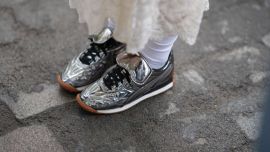Almost half of all porteños are considered to be living in a state of vulnerability or fragility, if not poverty, according to the new City Hall scales that measure quality of life. The figures from the Buenos Aires City government make for stark reading – even families with stable jobs are at risk with earnings denying them comfort.
Poverty studies habitually define as poor or destitute those persons who cannot cover the basic (63,300 pesos in this quarter) or food (33,600 pesos) shopping-baskets respectively. City Hall statisticians employ a third category, which they call the “Canasta Total,” where they add the goods and services consumed throughout the year (such as health products, seasonal goods or the renewal of consumer durables for housing needs).
The new measurements classify persons earning up to 77,600 pesos per household as “vulnerable.” Those described as “with fragile means” are at 97,000 pesos.
Within this panorama, nine percent of City citizens are destitute. An additional 17 percent are poor, with a total of 817,000 individuals below the poverty line, or 26.5 percent. Higher up the income scale a further 11 percent of porteños are “vulnerable,” while nine percent are “with fragile means” – some 619,000 persons or 20 percent between them.
Only 53 percent have a monthly family income topping 97,000 pesos and thus allowing them to cover the Canasta Total, of whom 45 percent are “middle class” and eight percent “upper class” – some 1.64 million people in total.
In the final three months of 2019, the last complete quarter before the pandemic with lockdown and all its dramatic public health and economic effects, the City's middle and upper classes totalled 61 percent, thus signifying a fall of eight percentage points in only 15 months.
Meanwhile those below the poverty line have risen from 22 to 27 percent while “vulnerable” or those “with fragile means” rose from 17 to 20 percent.
“We’re talking about a middle class which no longer has certain possibilities,” said Buenos Aires City Human Development Minister María Migliore.
These are families not statistically defined as poor but which find life increasingly difficult. Indeed, in recent times Migliore said her ministry has noted that soup kitchens outside low-income neighbourhoods in the capital (in zones like Constitución or Saavedra, for example) were seeing increasing numbers of people requesting food aid.
“Some nights we are distributing hot food to the homeless and what we see is people with a home approaching who need it too,” said the minister.
There are different factors impacting this situation but inflation, said Migliore, is the big problem, driving even some families with stable jobs and earnings into situations of fragility or even poverty.
The study gives three concrete examples. Firstly, a household containing a shop employee (average salary 43,500 pesos) and a building worker (50,000) whose combined 93,500 pesos would not cover the Canasta Total. The second example connects a self-employed worker (tax category B or 35,300 pesos) and an office messenger (42,000 pesos) whose combined earnings leave them “vulnerable.” Finally, the third pair is a house help (25,900 pesos) and a call centre employee (30,000 pesos) whose combined earnings do not meet the basic shopping-basket, thus leaving them below the poverty line.
Rise in homeless citizens
There are 2,573 people living rough in the capital, according to a City Hall survey taken last month. Of these people, 1,605 spend the night in social centres with 968 staying out on the street while 190 are under 18.
The main change is in social centres, which now absorb a big majority of the homeless, with the number of overnight stays up 93 percent from 2019.
City Hall recognises that the restrictions still in place last month surely prevented the total from being even higher since many street people cluster around restaurants.
These figures clash with those of the social organisations, which speak of over 7,000. The differences lie in the census being carried out over several days, the lack of reply, duplication of data and the grey area of people who live in the street without sleeping there.
– TIMES/PERFIL





















Comments